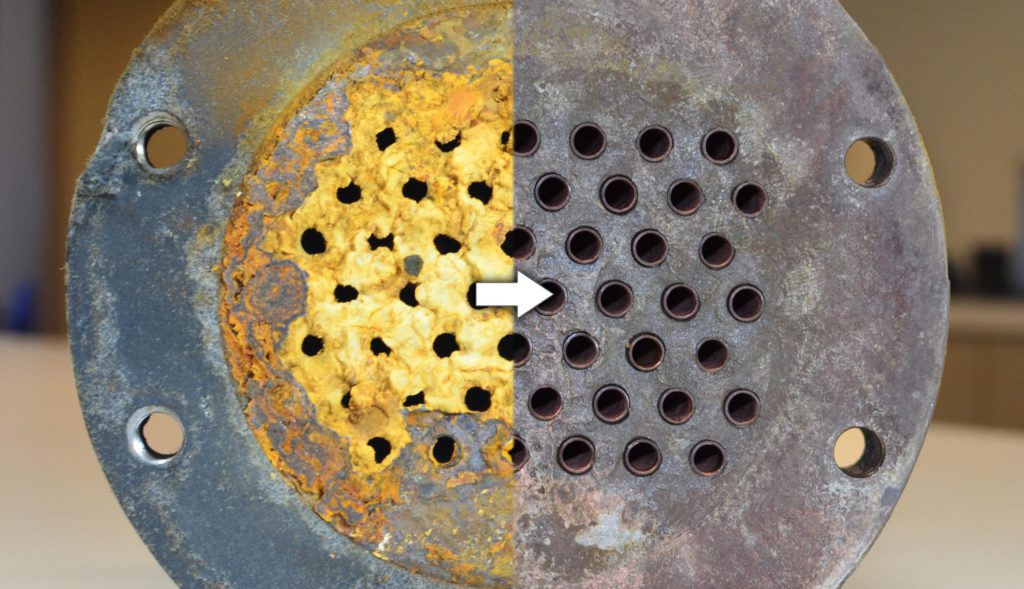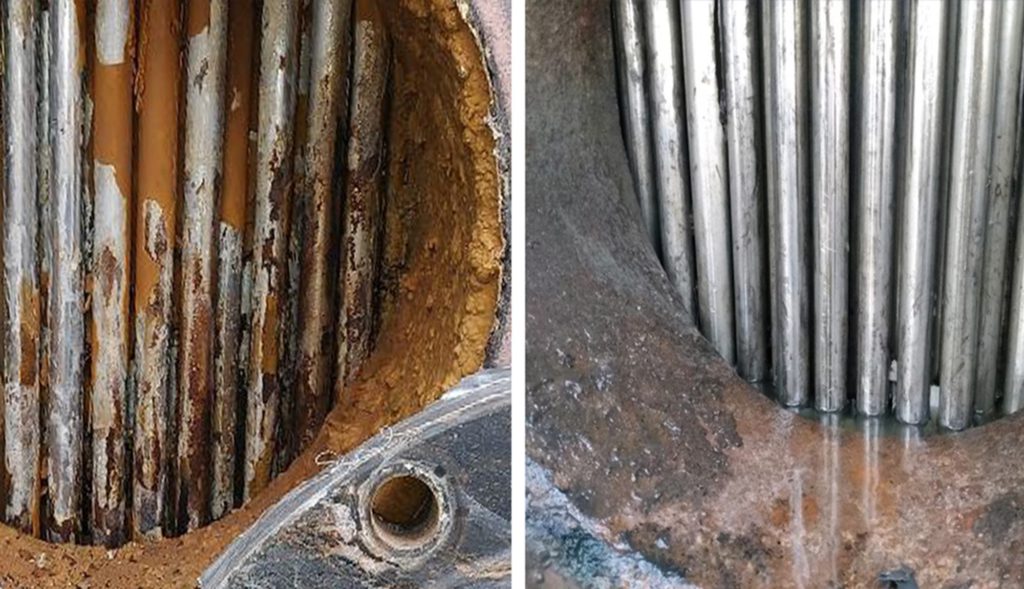Call for more information!
630-820-8888
Shell & Tube Heat Exchanger Cleaning
RYDLYME Descaler Preventative Maintenance | Shell and Tube Heat Exchanger Descaling
Scale accumulation in shell and tube heat exchangers can rob the equipment’s efficiency. This scale build-up can be made of rust, mineral deposits, calcium, limescale, and many other corrosive deposits. It is crucial that a preventative maintenance program be put in place utilizing RYDLYME Industrial Descaler and one of Apex Engineering Product’s RYDLYME Descaling Systems.
Even 1/32” of scale can cost thousands in extra spending to keep the equipment running! More importantly – leaving this scale build-up in the tubes of the heat exchanger can greatly reduce the lifespan of the equipment. Some scale is actually corrosive to the tube material, eating away at the tube walls! Removing this scale will ultimately increase the equipment’s lifespan and efficiency.
Shell and Tube Heat Exchanger Cleaning Methods
Just like in any industry, there is the hard way and the smart way of getting the job done. Traditional methods of tube cleaning such as rodding and hydro blasting are expensive, time-consuming, and often lead to equipment downtime. In some cases, it’s difficult to even get to the tubes to hydro blast or rod! This can also lead to production loss as well as revenue loss.
So, now that we’ve talked about the hard way to clean, let’s talk about the smart way to clean. Using RYDLYME Biodegradable Descaler to remove unwanted scale is easy, safe, and quick! The Leading Biodegradable Descaler, RYDLYME, is non-corrosive, non-hazardous, and can be disposed of easily! Descaling heat exchangers are made even easier with the use of one of our descaling systems!
Shell and Tube Heat Exchanger Cleaning Procedure
Apex Engineering Products has been around for more than 75 years manufacturing safe chemical solutions, so we know our way around a heat exchanger.
- Isolate and drain the water side of the exchanger to be cleaned.
- Place a 1” ball valve between the isolation valves and the heat exchanger on both the supply and return.
- Attach the RYDLYME pump and hoses so the RYDLYME will be pumped in the bottom or supply, and back out the top or return.
- Begin pumping all the required RYDLYME into the exchanger. Once that is accomplished, begin to add water to complete the circulation. Please note: The calcium deposit will take up volume within the heat exchanger, so you will not be able to add the same amount of water in the beginning.
- Continue circulating the solution for the recommended amount of time. As the circulation progresses and the product dissolves the deposits inside the unit, the volume will increase. To account for the increase in volume, please add water to the circulation vessel, as needed. If you begin adding a lot of water, please be aware, it is possible there is a leak in the system.
- It is a good idea to periodically check the effectiveness of the solution while circulation is in progress. This can be accomplished by utilizing a pH meter and as long as the solution retains a low pH, the product is active. Should the circulating solution reach a pH of 5.5 to 7.0 before the recommended time is up, you will need to add more RYDLYME and possibly extend the circulation time..
- Upon completion of the recommended circulation time, the solution may be purged to a normal sewer and flushed with water. This process is completed by placing the return hose in the drain and adding water to the circulation container until the discharge line runs clear.
- The unit is ready to be returned to service.
- The same instructions may be used for plate and frame-type heat exchangers. For volumes, please follow the noted formula.
Please note: If your situation dictates that you cannot take your heat exchanger off-line, please contact the manufacturer for on-line cleaning instructions.
RYDLYME FEATURES:
- Biodegradable
- Dissolves 2.2 lbs of scale per gallon of RYDLYME
- NSF/ANSI 60 certified
- Non-hazardous, non-corrosive and safe for personnel



